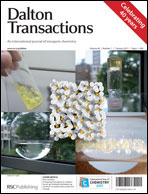Four new Cu(II) complexes {[Cu4(bpy)4(OH)4(H2O)2]}(NO3)2(C7H5O2)2·6H2O 1, {[Cu4(bpy)4(OH)4(H2O)2]}(NO3)2(C5H6O4)·8H2O 2, {[Cu4(bpy)4(OH)4(H2O)2]}(C5H6O4)2·16H2O 3 and {[Cu6(bpy)6(OH)6(H2O)2]}(C8H7O2)6·12H2O 4 were synthesized (bpy = 2,2′-bipyridine, H2(C5H6O4) = glutaric acid, H(C7H5O2) = benzoic acid, H(C8H7O2) = phenyl acetic acid). The building units in 1–3 are the tetranuclear [Cu4(bpy)4(H2O)2(μ2-OH)2(μ3-OH)2]4+ complex cations, and in 4 the hexanuclear [Cu6(bpy)6(H2O)2(μ2-OH)2(μ3-OH)4]6+ complex cations, respectively. The tetra- and hexanuclear cluster cores [Cu4(μ2-OH)2(μ3-OH)2] and [Cu6(μ2-OH)2(μ3-OH)4] in the complex cations could be viewed as from step-like di- and trimerization of the well-known hydroxo-bridged dinuclear [Cu2(μ2-OH)2] entities via the out-of-plane Cu–O(H) bonds. The complex cations are supramolecularly assembled into (4,4) topological networks via intercationic π⋯π stacking interactions. The counteranions and lattice H2O molecules are sandwiched between the 2D cationic networks to form hydrogen-bonded networks in 1–3, while the phenyl acetate anions and the lattice H2O molecules generate 3D hydrogen-bonded anionic framework to interpenetrate with the (4,4) topological cationic networks with the hexanuclear complex cations in the channels. The ferromagnetic coupling between Cu(II) ions in the [Cu4(μ2-OH)2(μ3-OH)2] cores of 1–3 is significantly stronger via equatorial-equatorial OH− bridges than via equatorial-apical ones. The outer and the central [Cu2(OH)2] unit within the [Cu6(μ2-OH)2(μ3-OH)4] cluster cores in 4 exhibit weak ferromagnetic and antiferromagnetic interactions, respectively. Results about i.r. spectra, thermal and elemental analyses are presented.
![Graphical abstract: New Cu(ii) complexes based on the hydroxo-bridged dinuclear [Cu(OH)2Cu] units: step-like di- and trimerizations of [Cu(OH)2Cu] units](/en/Image/Get?imageInfo.ImageType=GA&imageInfo.ImageIdentifier.ManuscriptID=B916719F&imageInfo.ImageIdentifier.Year=2011)
You have access to this article
 Please wait while we load your content...
Something went wrong. Try again?
Please wait while we load your content...
Something went wrong. Try again?
![Graphical abstract: New Cu(ii) complexes based on the hydroxo-bridged dinuclear [Cu(OH)2Cu] units: step-like di- and trimerizations of [Cu(OH)2Cu] units](/en/Image/Get?imageInfo.ImageType=GA&imageInfo.ImageIdentifier.ManuscriptID=B916719F&imageInfo.ImageIdentifier.Year=2011)

 Please wait while we load your content...
Please wait while we load your content...